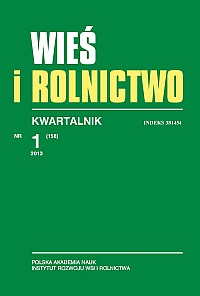Wahania cykliczne na rynku żywca wieprzowego na świecie i w wybranych krajach
Cyclical fluctuations in the pork market in the world and selected countries
Author(s): Andrzej Czyżewski, Sebastian StępieńSubject(s): Economy
Published by: Instytut Rozwoju Wsi i Rolnictwa Polskiej Akademii Nauk
Keywords: pig market; cyclical fluctuations; supply; prices; synchronization; global scale; rynek żywca wieprzowego; wahania cykliczne; podaż; ceny; synchronizacja; skala globalna
Summary/Abstract: The main objective of the publication is to examine the trends in the pork market in the global scale as well as in selected countries in the period 1991–2010. Authors attempt to identify convergences and divergences in the hog cycle between chosen countries and to find out the causes of fluctuations in supply and meat prices. On the basis of the literature overview it was found that the primary factor for fluctuations in hog production and pork prices was a spontaneous reaction of pig producers to the changes of profitability, that is determined by the relation of feed prices and livestock prices. Later studies indicated that the cause of fluctuations in the pork market is the lack of information leading to uncertainty, and the basic problem is the ability of farms to predict future market conditions and to response to the changing conditions. The empirical analysis covers the period 1991–2010 and includes the countries that have the highest share in the production of meat or are a major exporter of pork meat, such as China, USA, Canada, Brazil, Russia, EU countries (including primarily Germany, France, Spain, Denmark, Holland, Poland). The results of the study include the following conclusions: 1. processes of trade liberalization and the development of international cooperation did not lead to the convergence of cyclical fluctuations in the supply of pigs. They are individual for each country and are influenced by local conditions, related to the demand for meat, farm production resources and institutional arrangements; 2. as opposed to the supply, there is characteristic high convergence in pork meat prices between countries; 3. It was demonstrated that increasing trade and economic integration between the selected countries leads to the unification of hog cycle for price changes. Głównym celem publikacji jest zbadanie tendencji na rynku żywca wieprzowego w skali globalnej i wybranych krajach w latach 1991–2010. Podjęto próbę określenia zbieżności i rozbieżności cyklu świńskiego między krajami oraz wskazano na przyczyny zróżnicowania wahań podaży i/lub cen surowca. Na podstawie kwerendy źródłowej stwierdzono, iż pierwotnym czynnikiem fluktuacji produkcji i cen mięsa wieprzowego była spontaniczna reakcja producentów trzody na zmianę opłacalności chowu, determinowaną przez relację cen pasz do cen skupu żywca. Wskazano, iż przyczyną wahań jest brak informacji rynkowej prowadzący do niepewności, a podstawowym problemem jest zdolność gospodarstw rolnych do przewidywania przyszłych warunków rynkowych i w odpowiedzi wdrażania odpowiednich działań. Zaprezentowane wyniki analizy empirycznej dotyczą lat 1991–2010 i obejmują kraje, które mają największy udział w produkcji mięsa wieprzowego lub są znaczącym eksporterem surowca, tj. Chiny, USA, Kanadę, Brazylię, Rosję, kraje UE (w tym przede wszystkim Niemcy, Francję, Hiszpanię, Danię, Holandię, Polskę).
Journal: Wieś i Rolnictwo
- Issue Year: 158/2013
- Issue No: 1
- Page Range: 140-157
- Page Count: 18
- Language: Polish

